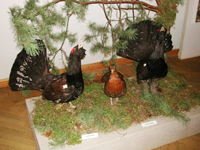|
Museum of Nature and Ecology "At the beginnings of the Dnieper"
Phone: (4812) 38-15-91
Address: 214000, Smolensk region, Smolensk City, Studencheskaya Street, 6. Ittemporarily works by the address: Smolensk City, Lenin Street, 8
Working hours:* on Tuesdays-Thursdays, Saturdays, Sundays - from 10.00 to 18.00; on Friday - from 10.00 to 17.00
Internet:
www.russianmuseums.info/M2317 - official web page
The Smolensk State Museum-Preserve - W1508, official web site www.smolensk-museum.ru/
E-Mail:
| billboard, events and excursions |  |
Description:
It's one of the oldest museums founded in 1908. The name of the museum had been changed for several times: the Natural-and-historical Museum, the N.M. Przhevalskiy Museum (1914), The Museum of Nature and the Local Land (1948-1977), the Museum of Natural History (since 2008). The museum had changed its location for many times up to the year of 1990, when a house at Studencheskaya Street was placed at its disposal. This house (Number 6) is in the process of restoration at present. The merit of the creation of the museum belongs to the Society of the Smolensk Province's Research. From the first years of its coming into being the museum was formed by the principle of plurality of profiles. Therefore equally with the natural science collections there were archaeological materials, ancient things and coins. The first exposition which had got accessible for visitors in 1913 had the type of an open demonstration of the museum's funds. At the expense of expeditions on collecting the samples of fauna and flora of the Smolensk Province the museum had got more than 3, 5 thousands of things in 1920th. Diverse research work of the museum's research officers had been reflected in their scientific works. At the end of 1930th the museum had become a significant object in the city; it attracted the attention of lovers of nature and of schoolchildren. In the years of the Great Patriotic War the museum's collections had been lost. The major of the Soviet Army A.S. Pavlov had disclosed some part of the zoological objects belonged to the museum at the territory of the occupied Poland and had given it back to the museum. After the War large credits were given out for the museum's reconstruction. Expeditions for collecting the exhibits, for researching into geology and minerals, into flora and fauna were sent into different districts of the Smolensk Region. The obtained materials had become the basis of the first postwar exposition which had beenoccupying the Church of St. John the Baptist(at the Cathedral Hill) up to the year of 1987. Since that time the search for the own building for the museum had been started again. And again the museum had to change its address more than once. In 1990 a three-storied building, a monument of architecture of the 19th century, with its aggregate floor space of 1376, 7m2 was given to the museum. It's situated atHouse № 6 Studencheskaya Street. The future exposition "At the beginnings of the Dnieper"will reflect the evolutionary character of the development of life onEarth, it'lldisclose the problems of the spiritual ecology and of the prospects of future of the planet, and it will acquaint the visitors with the nature of the Smolensk Region
|
Museum's building(s):
It's a public three-storied building of the 19th century made of bricks. The fasade brick-work has preserved the tracks of whitewashing. It's a big building with abundant decor typical for the period the eclectic architecture. Two upper floors are separated from the basis with an intermediate cornice. Up from it raise bundles of well-proportioned lesenes, which have their shortened correspondences with a rectangular panel as a crowning on the ground floor
|
|
Museum foundator: the Society of the Smolensk Province's Research (1903)
|
Museum's services:
museum shop, lecture hall
Next to the museum there are:
hotels and restaurants
| for museum professionals |  |
Administrative phone:
(4812) 38-15-91
Administrative address:
214000, Smolensk City, Communisticheskaya Road, 4
Foundation and opening day:
founded: 27.11.1908
Organisation status:
State Russia
Organization form:
non-for-profit
Organisation type:
culture for society, scientific, educational
Squares:
permament show rooms 940м2
temporary exhibitions 155,9м2
museum's store 42,8м2
museum's parks 0,3га
Employee number:
8 (curators: 4)
Average visitors per year:
7370
Collections volume:
более 12000, rare collection's items: 5260
Rare collections (unique items):
The herbarium of the angiosperm plantsA. Z. collected by Ishmenetskiy in the Smolensk Region in 1910 - 58 things
The herbarium of the plants collected by N. M. Przhevalskiy in the Mongolian expedition (partially preserved) - 308 things
Collection of insects collected by P. K. Kozlov in the Mongolian expedition in 1908 - 1909(partially preserved) -75 things
Collection of beetles collected by P. K. Kozlov in the Mongolian expedition in 1908 - 1909 years - 130 things
The herbarium of the of the environs of the village of Flyonovo of the Smolensk Province in 1912 year - 57 things
The collection of the samples of fossils and minerals of the Smolensk Region collected by the research officer of the Smolensk Scientific-Research Institute of Local Lore I. N. Salov in 1946 - 1961 years - 151 things
The collection of the vertebral animals recorded into the Red Book - 24 things
The collection of the fossilized flora of the Mikulinskoye interglacial period - 12 things
The collection of the fossilized animals of the Cenozoic era - 12 things
The samples of plants from the herbarium collected by N. M. Przhevalskiy in the Mongolian expedition (1870 - 1873) firstly described by the academician K. I. Maksimovich (isotypes) - 9 things
|

|
Web sites and CD-disks:
above 
Copyright (c) 1996-2024 Museum of Nature and Ecology "At the beginnings of the Dnieper"
Copyright (c) 1996-2025 Russian Museums .info
|

